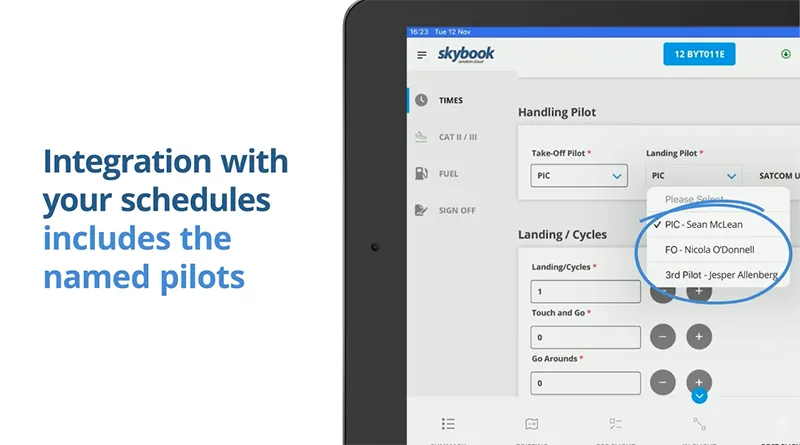
Leon Software Integration with skybook
Pilots can seamlessly record approach data on the post-flight phase of the skybook electronic flight bag (EFB); ensuring landing details are accurately captured on the Journey Log.
Logging information such as CAT III or landing cycles is straight forward in skybook and helps with pilot performance tracking and complying with regulations.
Let’s explore some of the post-flight landing data and its significance...
Category II (CAT II) and Category III (CAT III) refer to levels of instrument landing system (ILS) approach and landing minima used in aviation, specifically during low-visibility conditions.
These categories outline the minimum weather conditions, specifically visibility and decision height, under which aircraft can safely approach and land.

Here’s a breakdown of each:
CAT III is divided into three subcategories (CAT IIIa, IIIb, and IIIc), each with different minima.
CAT IIIa
CAT IIIb
CAT IIIC
A CAT IIIa runway is at Heathrow Airport (EGLL) in London, which is equipped for CAT IIIa and IIIb operations on several runways.
Heathrow’s ILS and lighting systems allow aircraft to land with very low visibility, typically down to 700 feet (200 meters) for CAT IIIa.
Logging landing approaches in skybook is simple, but why is it necessary for pilots to do? Here are the key reasons:
Proficiency and Recency Requirements
CAT II and CAT III approaches require specialized skills, as they are designed for low-visibility landings with specific decision heights and visibility limits.
Pilots must log these approaches to meet the recency requirements set by aviation authorities, such as the FAA or EASA, ensuring they remain proficient in handling low-visibility approaches.
Regulatory Compliance
Airlines and pilots must comply with regulations that require periodic proficiency checks, which include demonstrating the ability to perform CAT II and CAT III approaches.
Logged approaches serve as a record for audits and inspections to verify that pilots meet these standards.
Safety and Situational Awareness
Logging these approaches helps pilots and their operators track and assess any trends or issues in performance, allowing for additional training or support if necessary. Given the demanding nature of these approaches, maintaining experience is crucial for safety and situational awareness.
Aircraft and Operator Certification
Both the aircraft and the pilot require certification for CAT II and CAT III operations. Logging approaches can be part of proving compliance with these certifications, as only specific aircraft and crews are authorized to perform them.
Logging CAT II and CAT III approaches not only ensures pilots’ skills are up-to-date but also contributes to safer, more reliable operations under challenging conditions.
Selecting the handling pilot helps maintain pilot currency records and offers a straightforward audit trail for accessing flight history data when needed.
With our advanced integration capabilities, we can connect directly to your scheduling provider or data source, allowing flight crew details to be automatically populated on the EFB. 
Landing counts, cycles, touch-and-go events, and go-arounds can be logged and automatically sent to your technical records team.
But why are landing counts and cycles essential for technical records?
Here’s a few reasons:
Maintenance Scheduling
Each landing and flight cycle (one take-off and one landing) counts toward maintenance intervals for various components. Accurate records help teams plan for and schedule mandatory inspections and part replacements, ensuring ongoing airworthiness.
Component Life Tracking
Many aircraft components have life limits measured in cycles rather than flight hours. Tracking cycles is vital for monitoring the usage and wear of parts, like landing gear and engine turbines, which are more affected by the number of landings and take-offs than by time in the air.
Regulatory Compliance
Aviation authorities require strict adherence to maintenance schedules and life-limited part replacements. Recording cycles accurately ensures compliance, reduces risk of fines, and supports smooth audits.
Resale Value and Asset Management
Cycle counts contribute to assessing the remaining service life of an aircraft. Accurate cycle records can affect the aircraft’s resale value and provide prospective buyers with essential data for continued maintenance planning.
The significance of logging post-flight approach data and landing performance data, is fully realized when it is used to generate insightful reports for ground teams.
Once the pilot signs off the sector on the EFB, all Journey Log data syncs to the Reporting & Analytics dashboard, enabling flight operations to review, securely store, or export reports.
Specific data can also be automatically shared with other departments or integrated with third-party systems.

In addition to approach data, the flight crew uses the Journey Log on the EFB to capture landing performance and document the entire phase of flight.
To learn more about skybook or to schedule a quick demonstration, feel free to get in touch!